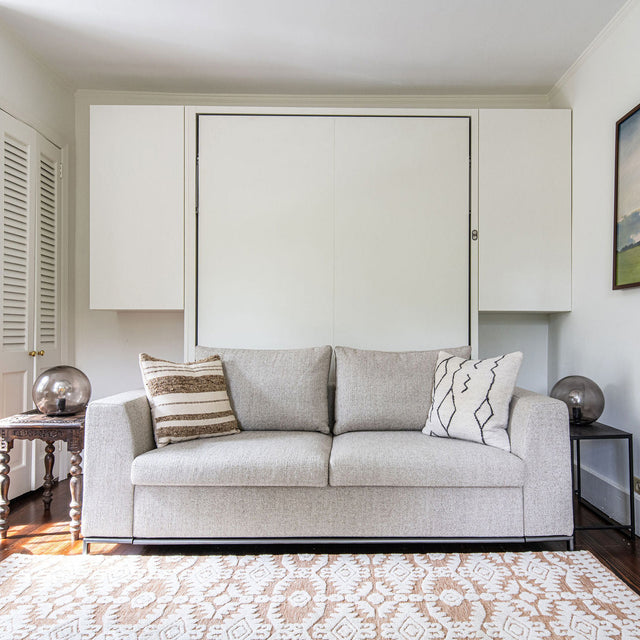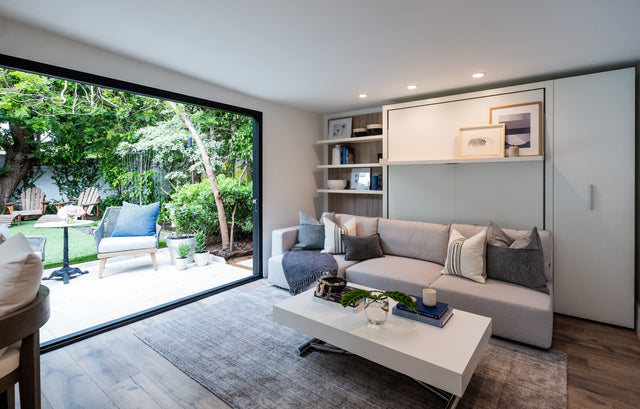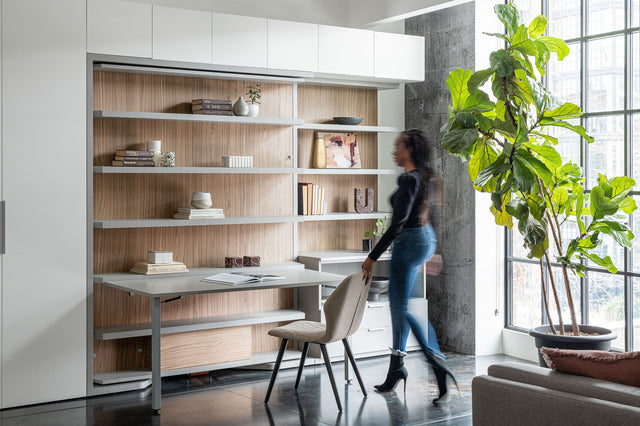Meet Pierluigi Colombo: Designer of the Modern Murphy Bed
How did wall beds evolve from ugly, hinged cabinets to today’s highly designed, multi-functional furniture systems? Thank the Colombo family, who completely re-envisioned the murphy bed over half a century ago.
In the Brianza region of Northern Italy — in the same city where his grandfather opened his own furniture business in 1907 — Pierluigi Colombo works as Art Director and Senior Product Designer at Clei, the world’s leading manufacturer of transforming and multi-functional furniture.
“The functionality of the murphy bed was clear, but so was the ugly design,” Pier explains. As a result, the murphy bed as a concept hadn’t quite taken off in the European market as it had in the States in the earlier half of the twentieth century.
When Pier’s father founded Clei in 1963, he saw the murphy bed’s space-saving and stylistic potential, but the operating mechanisms and overall design needed a complete overhaul. With a little innovation, transforming furniture could be reintroduced to the market as a stylish, practical solution that would significantly improve quality of life for people living in small urban spaces.
For example: instead of a wall or cabinet that simply hides your bed, why not design a second function into the murphy bed so it can be used 24 hours a day? In the 1970’s, Clei added a table to the classic pull-down bed, patenting the very first multi-functional wall bed design.
(Pierluigi can be seen operating a wall bed in this Clei ad from the early 1970’s)
Soon the company began to develop all variety of transformable systems — fold-away tables, morphing bunk beds, even a revolving queen-sized bed with an integrated full-height shelving system. And because of the modular design of Clei’s furniture systems, multiple transforming elements can be integrated into a single wall, working in tandem according to the user’s needs.
After studying architecture and design at the Kunst Akademie of Copenhagen and at Politecnico di Milano, Pier built on his father’s idea even further, designing Clei’s very first wall bed with an integrated sofa on its front.
Today Pier carries on the family legacy, working alongside his sister Roberta and his cousins, Luca and Barbara.

With his years of experience as an architect, Pier intuitively understands the need for space to function with greater usability. With more and more people moving into urban areas, space is at a premium — and the available housing stock is usually not equipped to meet the needs of the modern family.
In 2017, Pier partnered with Resource Furniture to design “The Open House,” a concept home designed to evolve with a family’s changing needs over time. Part of the Making Room exhibition at the National Building Museum, the Open House could accomodate all variety of households — roommates, multi-generational families, empty nesters renting out a room in their home — by way of movable walls and transforming elements.
Read our full interview with Pier below:
Having spent two months indoors, how has your relationship with your own space changed? How will people will perceive their spaces differently after this experience?
I think people are more aware of their own spaces and the problems that they face in those spaces, problems that they maybe never had to face before. Flexibility is even more important in a situation like this. At the moment I am talking from the Kali Desk [in my son’s room], for example. In the daytime, it’s my office. My wife works in the other room, our son plays in the living room, and I have plenty of space for my work. It works perfectly. If I have to keep on working into the evening, I move my things before my son goes to bed — or else he goes to sleep at midnight!
Without this transforming solution, working from home would be difficult. This is really like having a complete workstation.
For sure this experience will bring change, though I don’t know to what scale. But dealing with this situation has actually proved that many things are still possible, like working smarter from home.
In my experience, I’ve always worked from home on certain projects because I focus better when I work alone. The big question for us was whether meetings would still be possible. And we’ve seen that not only are they possible, but they’re more pragmatic than in-person meetings. We get to our solutions faster now because no one wants to stay on a phone call for more than two hours. If anything, I’m happy about this change!
How would you describe your philosophy as a designer? As an architect?
The mission for generally every architect, as the museum exhibition showed, is to start at the general scale — the uberplan — and then move down in scale to consider the interiors, and then finally the product. We [at Clei] have conducted extensive analysis concerning the changes in our society, and we’re seeing that spaces are getting smaller and prices are getting higher. So we are focused mainly on solutions for urban spaces. In the cities, especially in a city like New York, we have to make the best of every square inch. But you also have to offer quality, you have to offer comfort, you have to offer elegance.
The main thing that architect colleagues of mine are not aware of is the concept of flexibility. They’ve been taught to think about traditional spaces. There is a master bedroom, which is holy, untouchable — the bed, the wardrobe, the cabinets, full stop. There is a real gap in the culture in how we use a room in different ways over the course of a day.
In the children’s bedroom, this philosophy of flexibility has become more accepted. But it was always relegated to children’s bedrooms. If I were to issue catalog now, I wouldn’t even mention children’s bedrooms or ‘young spaces.’ I would simply call it a room.
A room is a room. You can use it some years for children, or you can use it for many different things based on necessity. It’s all about intelligent use of very expensive space. This is possible with the solutions that are available on the market, or with solutions that can be customized by an interior architect. But the subject is still not very acknowledged in the general culture of interior design.
Clei’s dynamic, transformable design is more intuitive than other ways of approaching design. We are working to find solutions that are beyond aesthetics, or rather that treat the aesthetic as taken for granted — it comes second to solving function.
Growing up with Clei — did that influence you to become an architect? Or does the fact that you are now an architect influence how you design for Clei?
Both; the two came together. I chose to join the business because I saw its potential from the very beginning. When I first started working for the company, they had issued maybe two or three models only — and those models were seen mainly as solutions for children’s bedrooms. I felt a responsibility to take this great idea and turn it into something bigger, something beyond these very narrow categories.
The process of developing this furniture typology started a long time ago. In the beginning, the company was looking to solve the problem of space. Over time, these typologies have evolved to provide real value not only by creating space, but by offering furniture with second functions and flexible solutions to meet the new needs of people today — specifically those living in big cities.
And in the end, without these transforming solutions, you cannot do that much. You can try to force a solution, like building smaller and smaller spaces, but that space still has to be livable and offer a high standard of quality to the people using it.
What were the first ideas you brought to Clei?
The first idea I brought to the company was the sofa in front of the murphy bed. That was originally my father’s idea, and I set out to refine the design of this product.
Before I joined the company, when I was still a student, I designed a murphy bed with only shelving on the front, no sofa. That product was called the Parenthesis, and it actually won a prize. But as often happens, the product that is winning the prizes is not necessarily the product that’s successful on the market. It was not selling very well. That’s when I found that people prefer to have a sofa rather than shelving; shelves can be installed on any wall and they’re quite cheap.
Remember at that time, this product typology was non-existent. There was only the foldable sofa bed — no sofa combined with a collapsible bed or murphy bed. This was the first ever, and immediately it received good feedback. From then, everything somehow started to develop in this field of transforming furniture.
That product was called the Liola. It functioned more as a traditional sofa, and it was not integrated in composition to the wall bed. Then came the Nuovoliola, which had improved technology and was visibly on a higher standard of quality from a design perspective.”
That was 20 years ago or more now that we introduced the Nuovoliola. Then we started to develop more and more and more sofas, focusing more on the comfort factor. We tried to not only to think about small spaces, but to provide a good space solution that did not comprise – a quality bed and a quality sofa, combined together.
In architecture, there's been a tendency to break down walls and create more open-plan solutions. Given this experience, do you think we may want more separation and acoustic division?
Separation is a necessity, but this can be achieved with some flexible solution, too. As we saw with the museum exhibit in Washington, there are flexible products [i.e. moveable walls] that allow you to create physical separation when necessary. Sometimes I think the problem of acoustic separation can be avoided with headphones. But you need physical separation to be somehow separated from what’s going on in your apartment. In this specific case I’m taking about what’s going on right now, but I’m also talking about how this could influence the future of design when we are of this pandemic.
I think it could be an interesting design subject — how to create acoustic separation that is flexible and can be removed when it’s not necessary.
How will architects and designers approach the home differently after this experience?
Homes should be designed so that everything can be somehow hidden. Everything has to transform according to the necessity; imagine if you have a virtual meeting and you have limited space, maybe you have to sit at the same table that you use to eat breakfast, lunch, and dinner. A better solution would be to make the table into something different so that you can create a temporary new environment. This is an interesting task that is not only dealing with furniture design, but with many other elements of design as well.
What are your greatest influences and inspirations? What are the ways you open your eyes to what is technologically possible in architecture and design?
Technology always offers new ways to produce things and new aesthetics. This is a field where it is important to always stay updated. When you’re just visiting design fairs, you see the end of the process but you don’t see what is beyond that — so its important to have dialogue with suppliers and to be always very curious to see how something can be done better.
I also like the decontextualization of things — approaching something from different fields, and bringing it into your own field. For example, these days my son is into stadium design. He’s drawing stadiums all the time. I told him to try and make something new, try to get some ideas by watching different objects. Watching a vase, watching a lamp, a pan — and it’s crazy what he came up with. He’s coming up with new shapes, new functions. He describes to me exactly the process of how he came to give it this function, because he got inspired by this or that object.
In our case, for Clei, the changing needs of people are very important to be aware of. We try to develop things that don’t exist because we’ve seen that there is a specific necessity for them.
Often times children’s items will start to leak into into adult spaces, until it seems the children have almost taken over the entire house. How do you manage to share space as a family?
In this time, every room is used by everybody. Of course, children cannot go out, so he mainly stays in the living room where he can play more freely.
But before the stay-at-home restrictions, there were certain things that our child cannot do in the living room. Certain things, he can do only in his bedroom. But one thing is for sure — the Kali Board has to be closed every morning. He knows that he has the entire floor available, and he has his own desk where he can design and work.
But this is not the general approach of most designers or of people that have to furnish their own homes. This is just a small example of flexibility, but without it, I wouldn’t know how to do it. Our quality of life, and especially my son’s quality of life, would be very much compromised with the bed always open, and homework to be done in the kitchen or all over the dining room table.
Of all the projects you've worked on, is there one that you're especially proud of?
The Open House was absolutely the most interesting project; it was not only working with the micro-unit, it was not only working with product design or technical walls, but it was working with the concept of space. The goal was to make a space that was flexible, where the function could change as the space was changing. It was experiment with the concept of a dynamic space that could transform 360 degrees.
As an architect, of course, I cannot only take from the Clei catalog. The concept of this dynamic space goes beyond that. So it was a new experience in that we could use products from other companies to address the space needs. I could combine products that were available on the market with custom designs to create new solutions that not only addressed the lack of space, but addressed the unique needs of the three completely different household scenarios.











